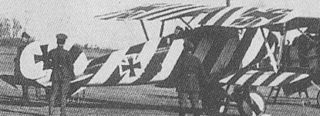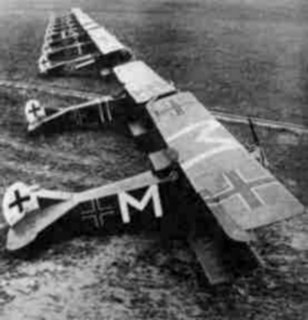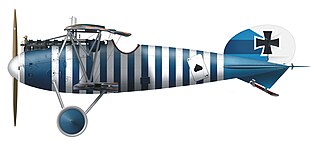Royal Prussian Jagdstaffel 38, commonly abbreviated to Jasta 38, was a "hunting group" of the Luftstreitkräfte, the air arm of the Imperial German Army during World War I. The unit would score 17 aerial victories during the war. The squadron's victories came at the expense of four losses, including one killed in action, one injured in a flying accident, and one wounded in action.

Royal Prussian Jagdstaffel 39, commonly abbreviated to Jasta 39, was a "hunting group" of the Luftstreitkräfte, the air arm of the Imperial German Army during World War I. The unit would score 68 aerial victories during the war, including 14 observation balloons downed. The squadron's victories came at the expense of seven pilots killed in action, one killed in a flying accident, five wounded in action, and one taken prisoner of war.
Royal Prussian Jagdstaffel 41, commonly abbreviated to Jasta 41, was a "hunting group" of the Luftstreitkräfte, the air arm of the Imperial German Army during World War I. The unit would score 73 aerial victories during the war, including ten observation balloons downed. The squadron's victories came at the expense of ten killed in action, two killed in flying accidents, three wounded in action, and one taken prisoner of war.
Royal Prussian Jagdstaffel 42, commonly abbreviated to Jasta 42, was a "hunting group" of the Luftstreitkräfte, the air arm of the Imperial German Army during World War I. The unit would score over 30 aerial victories during the war. The squadron's victories came at the expense of four killed in action, one wounded in action, and one taken prisoner of war.
Royal Prussian Jagdstaffel 43, commonly abbreviated to Jasta 43, was a "hunting group" of the Luftstreitkräfte, the air arm of the Imperial German Army during World War I. The unit would score over 35 aerial victories during the war, including two observation balloons downed. The squadron's victories came at the expense of six killed in action, five wounded in action, two injured in accidents, and one taken prisoner of war.
Royal Saxon Jagdstaffel 44, commonly abbreviated to Jasta 44, was a "hunting group" of the Luftstreitkräfte, the air arm of the Imperial German Army during World War I. The unit would score 19 aerial victories during the war, including four observation balloons downed. The squadron's victories came at the expense of two killed in action, two killed in flying accidents, two wounded in action, one injured in an accident, and two taken prisoner of war.
Royal Prussian Jagdstaffel 45, commonly abbreviated to Jasta 45, was a "hunting group" of the Luftstreitkräfte, the air arm of the Imperial German Army during World War I. The squadron would score over 113 aerial victories during the war, including 28 observation balloons downed. The unit's victories came at the expense of four pilots killed in action, two injured in flying accidents, and five wounded in action.
Royal Württemberg Jagdstaffel 64, commonly abbreviated to Jasta 64, was a "hunting group" of the Luftstreitkräfte, the air arm of the Imperial German Army during World War I. The squadron would score 20 or more aerial victories during the war. The unit's victories came at the expense of three wounded in action, and three taken prisoner of war.
Royal Prussian Jagdstaffel 67, commonly abbreviated to Jasta 67, was a "hunting group" of the Luftstreitkräfte, forerunner to the Luftwaffe. The squadron would score over 34 aerial victories during the war, including 17 observation balloons downed. The unit's victories came at the expense of one pilot killed in action, one wounded in action, and two taken prisoner of war.
Royal Prussian Jagdstaffel 68, commonly abbreviated to Jasta 68, was a "hunting group" of the Luftstreitkräfte, the air arm of the Imperial German Army during World War I. The squadron would score over 40 aerial victories during the war, including ten observation balloons downed. The unit's victories came at the expense of nine killed in action, and two wounded in action.
Royal Prussian Jagdstaffel 69, commonly abbreviated to Jasta 69, was a "hunting group" of the Luftstreitkräfte, the air arm of the Imperial German Army during World War I. The squadron would score 15 aerial victories during the war, including two observation balloons downed. The unit's victories came at the expense of one pilot killed in action, three killed in flying accidents, one wounded in action, and three taken prisoner of war.
Royal Prussian Jagdstaffel 70, commonly abbreviated to Jasta 70, was a "hunting group" of the Luftstreitkräfte, the air arm of the Imperial German Army during World War I. The squadron would score over 14 aerial victories during the war. The unit's victories came at the expense of two killed in action and three wounded in action.

Royal Saxon Jagdstaffel 72, commonly abbreviated to Jasta 72, was a "hunting group" of the Luftstreitkräfte, the air arm of the Imperial German Army during World War I. The squadron would score over 58 aerial victories during the war, including three observation balloons downed. The unit's victories came at the expense of two killed in action, one wounded in action, and one taken prisoner of war.
Royal Prussian Jagdstaffel 73, commonly abbreviated to Jasta 73, was a "hunting group" of the Luftstreitkräfte, the air arm of the Imperial German Army during World War I. squadron would score 29 aerial victories during the war, including seven night victories, and including an observation balloon downed. The unit's victories came at the expense of three killed in action.
Royal Prussian Jagdstaffel 75, commonly abbreviated to Jasta 75, was a "hunting group" of the Luftstreitkräfte, the air arm of the Imperial German Army during World War I. The squadron would score four aerial victories during the war, including an observation balloon downed. The unit's victories came at the expense of one wounded in action.
Royal Bavarian Jagdstaffel 76, commonly abbreviated to Jasta 76, was a "hunting group" of the Luftstreitkräfte, the air arm of the Imperial German Army during World War I. The squadron would score over 20 aerial victories during the war. The unit's victories came at the expense of six killed in action, four wounded in action, and three taken prisoner of war.
Royal Bavarian Jagdstaffel 77, commonly abbreviated to Jasta 77, was a "hunting group" of the Luftstreitkräfte, the air arm of the Imperial German Army during World War I. The squadron would score over 28 aerial victories during the war, including three observation balloons downed. The unit's victories came at the expense of four killed in action, one killed in a flying accident, one wounded in action, three injured in aviation accidents, and one taken prisoner of war.
Royal Bavarian Jagdstaffel 78, commonly abbreviated to Jasta 78, was a "hunting group" of the Luftstreitkräfte, the air arm of the Imperial German Army during World War I. The squadron would score over eight aerial victories during the war, including one observation balloon downed. The unit's victories came at the expense of two killed in action, one killed in flying accidents, and three wounded in action.

Royal Bavarian Jagdstaffel 79, commonly abbreviated to Jasta 79, was a "hunting group" of the Luftstreitkräfte, the air arm of the Imperial German Army during World War I. The squadron would score over 28 aerial victories during the war, including three observation balloons downed. The unit's victories came at the expense of four killed in action, three killed in flying accidents, 13 wounded in action, two injured in aviation accidents, and three taken prisoner of war.
Royal Bavarian Jagdstaffel 80, commonly abbreviated to Jasta 80, was a "hunting group" of the Luftstreitkräfte, the air arm of the Imperial German Army during World War I. The squadron scored 15 aerial victories during the war, including four observation balloons downed. The unit's victories came at the expense of two killed in action, three killed in flying accidents, two injured in accidents, six wounded in action, and one taken prisoner of war.









